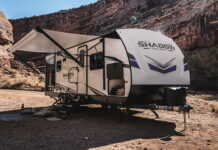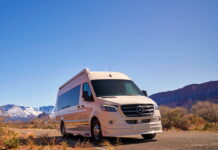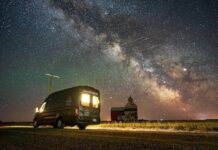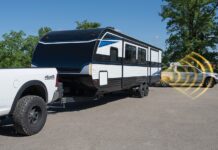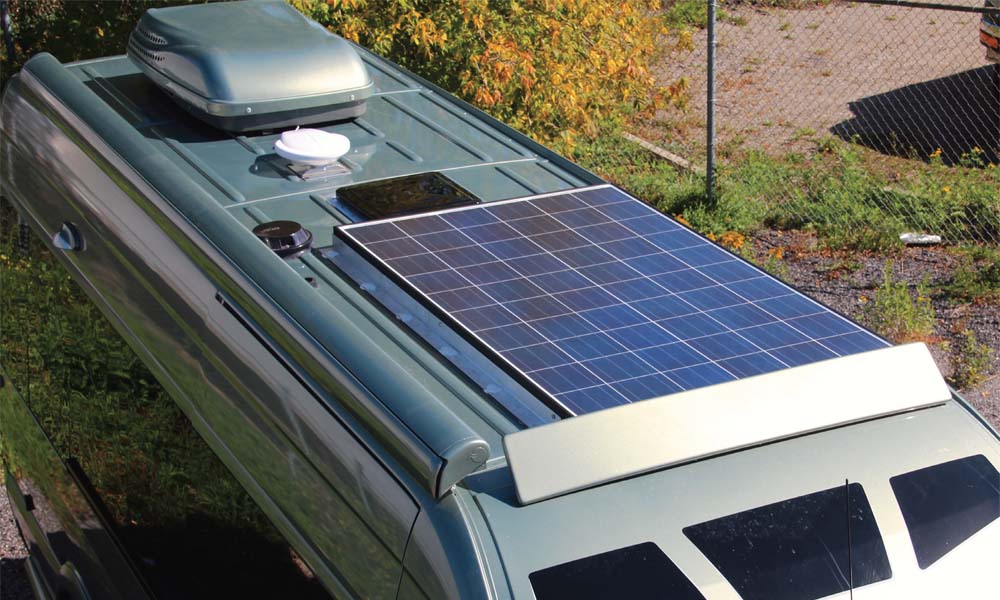GOING GREEN: Using Solar Power
With the rising fuel costs to run generators or during those times when power is limited, seeking solar power sources has been a popular alternative as more and more technology is being introduced. Believe it or not, RVs are the best type of units to utilize solar power. Most electrical systems in an RV are designed to work from 12 volts DC, with exception of an A/C unit or microwave, which require 120 volts AC.
Most RVs come with a battery used to start the engine, plus two deep-cycle batteries to operate lights, pumps, furnaces, or radios. Some even come with a generator. Most RVs also use either ‘group 24’ or ‘group 27’ batteries for the coach. A group 24 battery can provide 70 ampere-hours of energy at a 10-ampere discharge rate. Group 27 batteries can provide 90 ampere-hours of energy at a 10-ampere discharge rate.
This means that if you draw 10 amperes of current from your battery for a period of nine hours, your battery will be completely discharged. Two batteries would allow 18 hours. If you draw 50 amperes from one battery it will be dead in 70 minutes. As higher currents are drawn, the battery temperature increases and can provide current for a shorter time.
Generators are used to provide 120 volts Alternating Current (AC) to run an air conditioning system or microwave and its output is converted to 12 volts Direct Current (DC) to charge the batteries. They run on gasoline, diesel, or propane fuel and certainly costs money to generate electricity.
A generator costs about $4,000 (or more) and is often only used for a few hours each month. To properly maintain the generator, approximately $300 is required for every 400 hours of use. During this time, the generator will also use about $985 in fuel per season and is often running while driving or when you want to operate the roof-air. With many RVs, the only time you can run the rear or bedroom air conditioner is if you have a larger generator such as a 7000- watt unit that provides enough current to operate both air conditioners on the RV. The bedroom air conditioning system is only connected to the generator, unless you have an RV with a 50 ampere 220- volt system, which is not available in many campgrounds.
Why Choose Solar Power?
There are many benefits to using solar technology as an alternate power source. For instance, a 200-watt solar array can be installed for about the same cost as a generator. It’s quiet, doesn’t require fuel (of any kind) to operate, and there is no annual maintenance fee. It even works when the RV is stored outdoors, quietly keeping the battery system in top working order. It provides all this with a 10-year warranty.
A solar system will not operate an air conditioner, but it can easily operate a microwave with an inverter. Most RVers install solar panels on the roof of their RV and use the system to keep their batteries up to full charge. As long as there is some daylight each day, the batteries can be topped up even if the RV isn’t being used.
An RV battery that is not kept properly charged has a short life. Good deepcycle batteries can cost $120 to $300 and seem to need replacing every few years. I always suggest using one battery for each solar panel. Groups of sixvolt AGM deep-cycle batteries are the preferred choice of solar panel users. Remember, it’s impossible to recharge both batteries overnight when you are plugged in at the campground unless you have an auxiliary high current charging system.
The solution is to replace the energy as it is being used with solar cells. Energy consumed during the evenings can be replaced by the solar cells during daylight. A four-panel solar cell array can supply 12 or more amperes, depending on the brilliance of the sun as well as the angle the light strikes the panel and temperature.
Solar cells, too, are more efficient in cooler temperatures so they may lose some of their ability to generate current in hotter, southern climates. Additionally, the available light doesn’t need to be direct sunlight as diffused light on an overcast day can still produce an acceptable amount of current to charge the batteries.
While more expensive solar cell panels are self-regulating, other less expensive system are not, which means as the sun gets brighter, the output voltage keeps rising. Units such as this are fine for use on something like a ceiling fan, which will only go faster if the sun gets brighter. But many appliances require a regulated source of electricity. A cooling fan can assist the normal convection air currents to take heat away from the fridge when the sun is beating down. If the sun is not shining, the fan stops working since it is not needed.
Properly installed solar arrays (groups of solar panels connected together) to charge batteries should be installed with voltage regulators and controllers to prevent the output voltage from going too high and over heating the battery system. The controller also disconnects the array from the batteries when the array voltage drops lower than the batteries. This prevents the batteries from discharging into the solar cells.
When using solar power technology, conservation of energy helps batteries last longer. Also, perhaps consider upgrading the lighting system to fluorescent or LED lamps as fluorescent lamps develop 80 percent light with only 20 percent heat and have a much longer and durable life span. Additionally, both Fluorescent and LED lamps provide more light with less heat and current used. Besides saving your battery, you won’t need as much air conditioning to get rid of unwanted heat.
A natural complement to solar panels for an RV is an Inverter. This device will change the 12 volt DC developed by the solar system to 120 volts, alternating the current to operate equipment such as televisions, VCRs, microwave ovens, and lights. An inverter is designed to power appliances that draw low wattage for a long time or high wattage devices for a very short time.
When solar panels and inverters are installed on an RV, the 120 volt electrical panel should be rewired into two sections – one section is usually used to operate a TV, VCR, microwave and other low wattage 120 volt appliances, while the other section of the electrical panel is only used when you are plugged into the electrical system of a campground (or when the generator is running) to operate the converter, air conditioner and any other high wattage 120 volt appliances.
The inverter should be mounted in a dry area not far from the battery system so that the 12-volt wiring does not have to be too large in diameter. But, it should NOT be located in the battery compartment where it will be subject to corrosive fumes that come from the batteries during high current drains that occur during operation of the inverter. Remember, the inverter is used for low wattage 120-volt appliances and devices that you need to make life bearable on the road and in the back country campgrounds without the noise of a generator in the background.
An owner can estimate the number of solar cells panels required by calculating the total number of watt-hours of energy required from the RV. The wattage drawn is usually marked on a nameplate at the back of each appliance. If the figure shown is amperes, calculate the wattage by multiplying by the normal voltage. Estimate the number of hours each appliance will be used each day, then add up the watthour requirements of your RV for the day. Each 37-inch panel can generate an average of 4.4 amperes at 12 volts (or 53 watts) during each hour of sunlight. With an average of four hours of sunlight each day, each 53-watt panel can generate 1484 watt-hours of energy.
Solar energy is a natural move for RVs and RVing. It can certainly boost the enjoyment of camping in Provincial, State and National Parks where you are free of electrical cords and pollution. Enjoy the back country and catch the sun.







